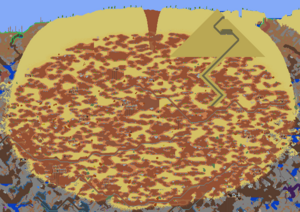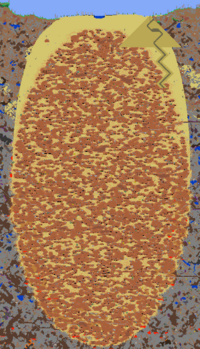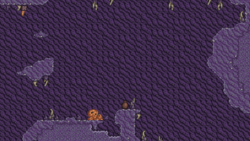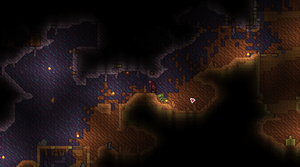Underground Desert
The Underground Desert is a biome located directly underneath the main Desert of the world. The Desert above may generate different features which inform that the Underground Desert is underneath (see Surface Desert below for details). The Desert/Underground Desert pair will always generate on the same side of the world the Jungle is on.
The structure of the Underground Desert resembles that of a real-world ant hive, featuring numerous small caves mainly composed of Sandstone Blocks and Hardened Sand Blocks, which are connected in varying degrees. It is always either circular or oval in shape and is very large, rivaling even the Dungeon in size. Many types of Antlion enemies inhabit the Underground Desert, and it is also riddled with traps, namely Antlion Eggs, Rolling Cacti, and sand traps, making it a challenge to navigate.
The Underground Desert becomes significantly more challenging in Hardmode. Along with harder enemies, it is extremely vulnerable to conversion by Corruption, Crimson, or Hallow due to Sand, Hardened Sand, and Sandstone all being susceptible to conversion. Conversion further strengthens the Underground Desert's enemies, and in Corruption and Crimson Underground Deserts causes the spawn of Desert Spirits.
Removing the background walls will remove the biome in a similar fashion to Spider Nests.
Contents
 Antlion
Antlion Antlion Charger(Desktop, Console and Mobile versions)
Antlion Charger(Desktop, Console and Mobile versions) Antlion Larva(Desktop, Console and Mobile versions)
Antlion Larva(Desktop, Console and Mobile versions) Antlion Swarmer(Desktop, Console and Mobile versions)
Antlion Swarmer(Desktop, Console and Mobile versions) Golfer(Desktop, Console and Mobile versions)
Golfer(Desktop, Console and Mobile versions) Giant Antlion Swarmer(Desktop, Console and Mobile versions)
Giant Antlion Swarmer(Desktop, Console and Mobile versions) Giant Antlion Charger(Desktop, Console and Mobile versions)
Giant Antlion Charger(Desktop, Console and Mobile versions) Sand Slime(Desktop, Console and Mobile versions)
Sand Slime(Desktop, Console and Mobile versions) Tomb Crawler(Desktop, Console and Mobile versions)
Tomb Crawler(Desktop, Console and Mobile versions)
 Basilisk(Desktop, Console and Mobile versions)
Basilisk(Desktop, Console and Mobile versions) Sand Poacher(Desktop, Console and Mobile versions)
Sand Poacher(Desktop, Console and Mobile versions)
 Lamia(Desktop, Console and Mobile versions)
Lamia(Desktop, Console and Mobile versions) Dune Splicer(Desktop, Console and Mobile versions)
Dune Splicer(Desktop, Console and Mobile versions) Ghoul(Desktop, Console and Mobile versions)
Ghoul(Desktop, Console and Mobile versions) Vile Ghoul(Desktop, Console and Mobile versions)(Corrupt)
Vile Ghoul(Desktop, Console and Mobile versions)(Corrupt) Tainted Ghoul(Desktop, Console and Mobile versions)(Crimson)
Tainted Ghoul(Desktop, Console and Mobile versions)(Crimson) Dreamer Ghoul(Desktop, Console and Mobile versions)(Hallowed)
Dreamer Ghoul(Desktop, Console and Mobile versions)(Hallowed) Desert Spirit(Desktop, Console and Mobile versions)(Corrupt, Crimson)
Desert Spirit(Desktop, Console and Mobile versions)(Corrupt, Crimson)
 Mandible Blade(Desktop, Console and Mobile versions)
Mandible Blade(Desktop, Console and Mobile versions)
 Banana Split(Desktop, Console and Mobile versions)
Banana Split(Desktop, Console and Mobile versions)
 Sturdy Fossil(Desktop, Console and Mobile versions)
Sturdy Fossil(Desktop, Console and Mobile versions)
 Ancient Cloth(Desktop, Console and Mobile versions)
Ancient Cloth(Desktop, Console and Mobile versions)
 Desert Spirit Lamp(Desktop, Console and Mobile versions)
Desert Spirit Lamp(Desktop, Console and Mobile versions) Djinn's Curse(Desktop, Console and Mobile versions)
Djinn's Curse(Desktop, Console and Mobile versions)
 Sturdy Fossil(Desktop, Console and Mobile versions)
Sturdy Fossil(Desktop, Console and Mobile versions) Ancient Horn(Desktop, Console and Mobile versions)
Ancient Horn(Desktop, Console and Mobile versions)
 Fried Egg(Desktop, Console and Mobile versions)
Fried Egg(Desktop, Console and Mobile versions)
 Desert Key(Desktop, Console and Mobile versions)(1/2500 chance)
Desert Key(Desktop, Console and Mobile versions)(1/2500 chance)
 Ancient Chisel(Desktop, Console and Mobile versions)
Ancient Chisel(Desktop, Console and Mobile versions) Dunerider Boots(Desktop, Console and Mobile versions)
Dunerider Boots(Desktop, Console and Mobile versions) Storm Spear(Desktop, Console and Mobile versions)
Storm Spear(Desktop, Console and Mobile versions) Thunder Zapper(Desktop, Console and Mobile versions)
Thunder Zapper(Desktop, Console and Mobile versions) Magic Conch(Desktop, Console and Mobile versions)
Magic Conch(Desktop, Console and Mobile versions) Encumbering Stone(Desktop, Console and Mobile versions)
Encumbering Stone(Desktop, Console and Mobile versions) Bast Statue(Desktop, Console and Mobile versions)
Bast Statue(Desktop, Console and Mobile versions) Snake Charmer's Flute(Desktop, Console and Mobile versions)
Snake Charmer's Flute(Desktop, Console and Mobile versions) Desert Minecart(Desktop, Console and Mobile versions)
Desert Minecart(Desktop, Console and Mobile versions)
 Hardened Sand Block(Desktop, Console and Mobile versions)
Hardened Sand Block(Desktop, Console and Mobile versions) Sandstone Block(Desktop, Console and Mobile versions)
Sandstone Block(Desktop, Console and Mobile versions) Desert Fossil(Desktop, Console and Mobile versions)
Desert Fossil(Desktop, Console and Mobile versions) Sand Block
Sand Block Amber
Amber Ebonsand Block
Ebonsand Block Hardened Ebonsand Block(Desktop, Console and Mobile versions)
Hardened Ebonsand Block(Desktop, Console and Mobile versions) Ebonsandstone Block(Desktop, Console and Mobile versions)
Ebonsandstone Block(Desktop, Console and Mobile versions) Crimsand Block
Crimsand Block Hardened Crimsand Block(Desktop, Console and Mobile versions)
Hardened Crimsand Block(Desktop, Console and Mobile versions) Crimsandstone Block(Desktop, Console and Mobile versions)
Crimsandstone Block(Desktop, Console and Mobile versions) Pearlsand Block
Pearlsand Block Hardened Pearlsand Block(Desktop, Console and Mobile versions)
Hardened Pearlsand Block(Desktop, Console and Mobile versions) Pearlsandstone Block(Desktop, Console and Mobile versions)
Pearlsandstone Block(Desktop, Console and Mobile versions)
 Underground Desert(Desktop, Console and Mobile versions)
Underground Desert(Desktop, Console and Mobile versions) Desert (Otherworldly)(Desktop, Console and Mobile versions)
Desert (Otherworldly)(Desktop, Console and Mobile versions)
Surface Desert

The Desert above the Underground Desert may generate with various surface features, including one or more Oasis mini-biomes, or one of several types of the entrance. There is a 1/3 (33.33%) chance that a world's main Desert will contain one of the various types of the entrance. These can assist in locating and accessing the Underground Desert from the surface. The presence of an Oasis does not indicate where the Underground Desert is, as the Oasis mini biomes can generate atop any of the world's Deserts, regardless of which of them contains the Underground Desert biome.
It is possible for one or more Pyramids to generate in the main Desert. When this happens, the Pyramid will often extend somewhat into the Underground Desert, and thus its tunnel can provide another easy means of entry. As with the Oasis mini-biome, Pyramids can generate in any of the world's Deserts, regardless of where the Underground Desert is located, and so their presence does not guarantee that the Underground Desert is below.
See Desert for more information about the surface entrances to the Underground Desert.
Notes
- It is possible to create an artificial Underground Desert by placing a sufficient amount of Sandstone and Hardened Sand Blocks, and Sandstone and Hardened Sand Walls. Regular Sandstone Walls and Hardened Sand Walls cannot be used, as they are considered safe when placed and will prevent enemy spawns.
- The "Treacherous" variants of these walls are considered unsafe when placed and will allow enemy spawns. They are obtained through Shimmer transmutation.
- Alternatively, the Clentaminator and Terraformer facilitate converting a variety of safe walls into unsafe Sandstone/Hardened Sand Walls. For instance, spraying Blue Solution onto safe Sandstone Walls will convert them into unsafe Pearlsandstone Walls. There are numerous other possibilities, like using Yellow Solution on safe Stone Walls or Green Solution on safe Hardened Ebonsand Walls. See Solutions § Conversions for the complete list.
- The border between the Underground Desert and the Cavern layer often feature pools of lava much closer to the surface than where lava would normally generate.
Spawning mechanics
None of the Underground Desert enemies require an actual Desert biome to spawn. The three "tainted" Ghouls each only spawn in their respective Corrupt/Crimson/Hallowed biomes. When in an evil biome, dark-haired Lamia will replace their counterpart and Desert Spirits will replace Sand Poachers. Antlion Larvae only spawn when Antlion Eggs are broken.
To successfully spawn an enemy on a selected tile, the following checks are done:
- The spawn tile must be more than 10 tiles in from any edge of the world, including unreachable tiles.
- The spawn tile must be below the halfway point between the Surface and the top of the world, including the unreachable tiles.
- The spawn tile can be any active (not actuated) solid block, which includes platforms or any other valid spawning surface.
- The wall behind the spawn point must be either Sandstone Wall (or its "tainted" variants) or Hardened Sand Wall (or its "tainted" variants), and it must be unsafe.
Tips
- The enemies are very dangerous early on, so it is advised to have ample Grenades on hand as well as some form of movement-based Accessory to make it less difficult to deal with them. Gold/Platinum armor is recommended due to the high damage dealt by the Antlion Swarmers and Chargers.
- Minions give several advantages in the underground desert that most other weapons do not. The underground desert's main dangers are fast-moving, knockback resistant enemies and rolling cacti. Minions counteract these by being summonable on the other side of walls, reacting to quick-moving enemies without requiring player interactions, contributing knockback independently of the player's actions, and triggering rolling cacti remotely (which may require summoning them directly on the cacti multiple times or waiting to summon them until an enemy passes by).
Trivia
- In the real world, larval antlions creates funnel-like pits in the ground and fling sand at prey that pass by. The funnel and burrow entrance types to the Underground Desert are presumably inspired by this.
- Prior to 1.4.0.1, the Desert above the Underground Desert would always contain a large Pit-style entrance. This made it easier to find and access the Underground Desert.
History
- Desktop 1.4.4:
- Increased the minimum size of Underground Deserts from 50% of the maximum size to 75% of the maximum. The maximum size has not increased.
- Changed the Underground Desert mob spawn conditions from a column of 50 natural wall to just the 1 behind the spawn block.
- Desktop 1.4.0.1:
- Added Sandstone Chests in world generation.
- Generation changed to make the biome go to varying depths, making it much deeper than in previous versions.
- Introduced a brand-new music track for the Underground Desert.
- Lava now spawns at lower levels towards the edge of the biome.
- The Desert above the Underground Desert may now generate other features than the funnel entrance, and the funnel design has also changed.
- Desktop 1.3.3: Increased spawn rates.
- Desktop 1.3.0.1: Introduced.
- Console 1.0.933.1: Introduced. (
)
- Console 1.0.750.0: Introduced. (
)
- Switch 1.0.711.6: Introduced.
- Mobile 1.3.0.7: Introduced.




